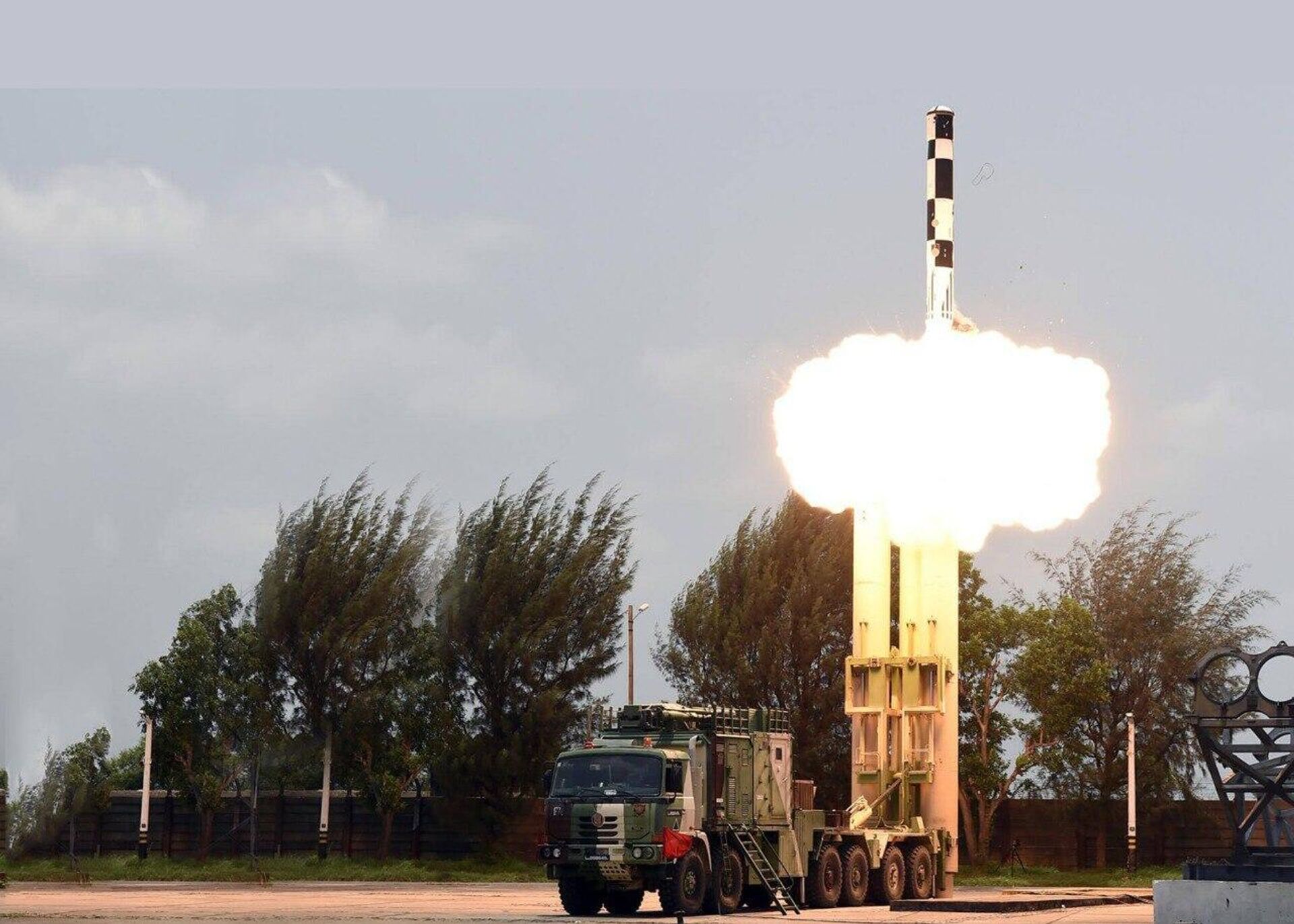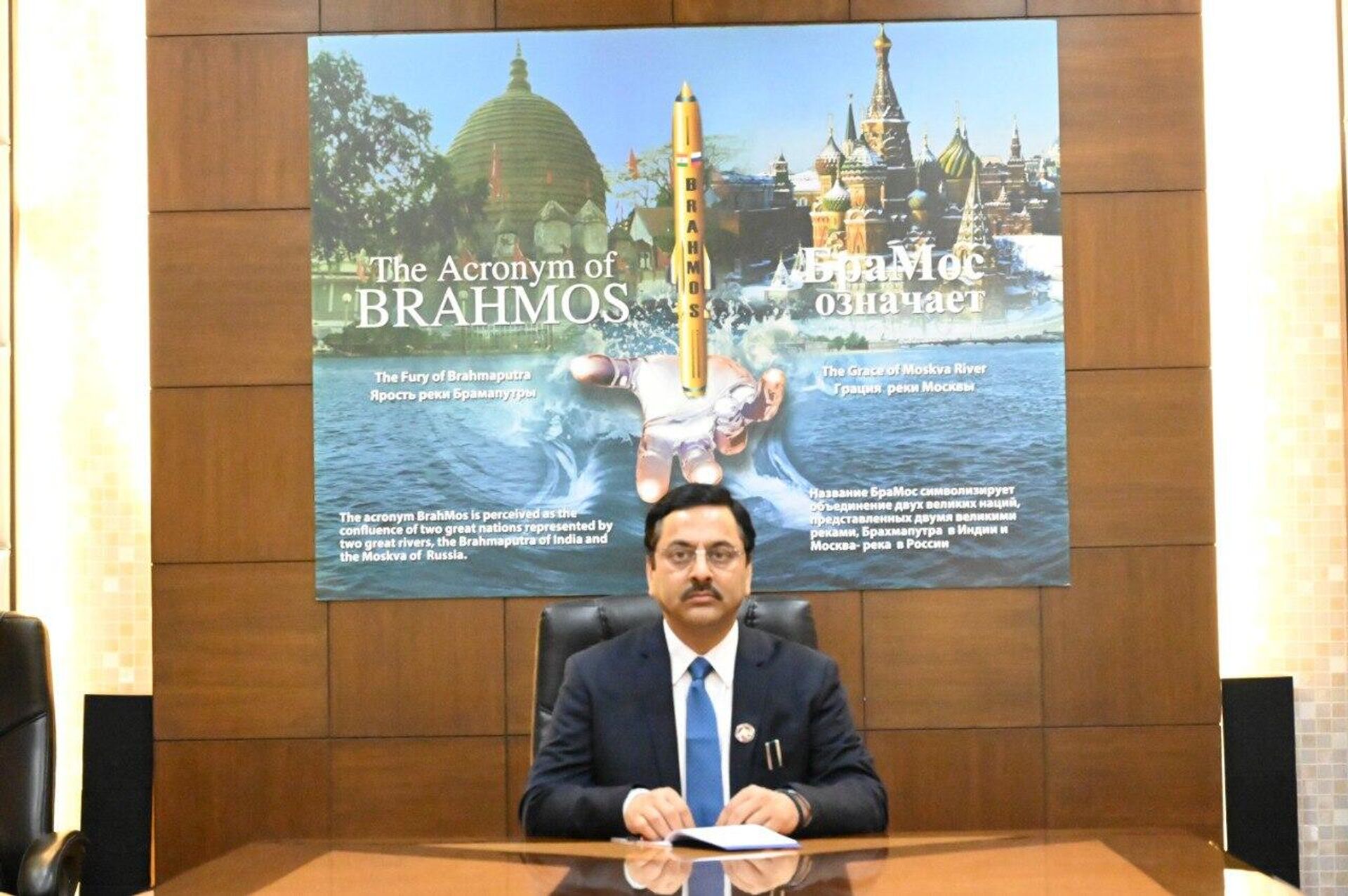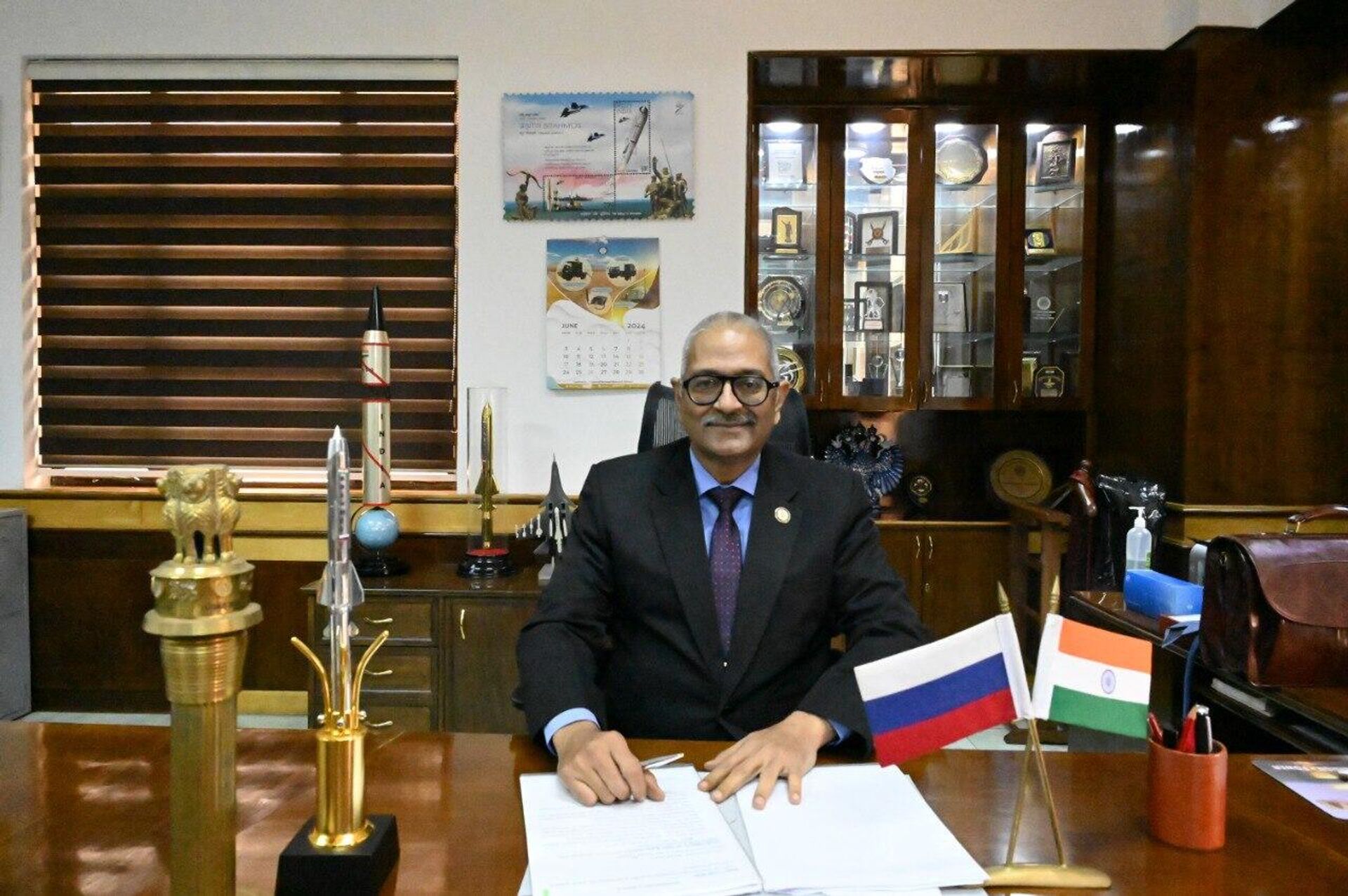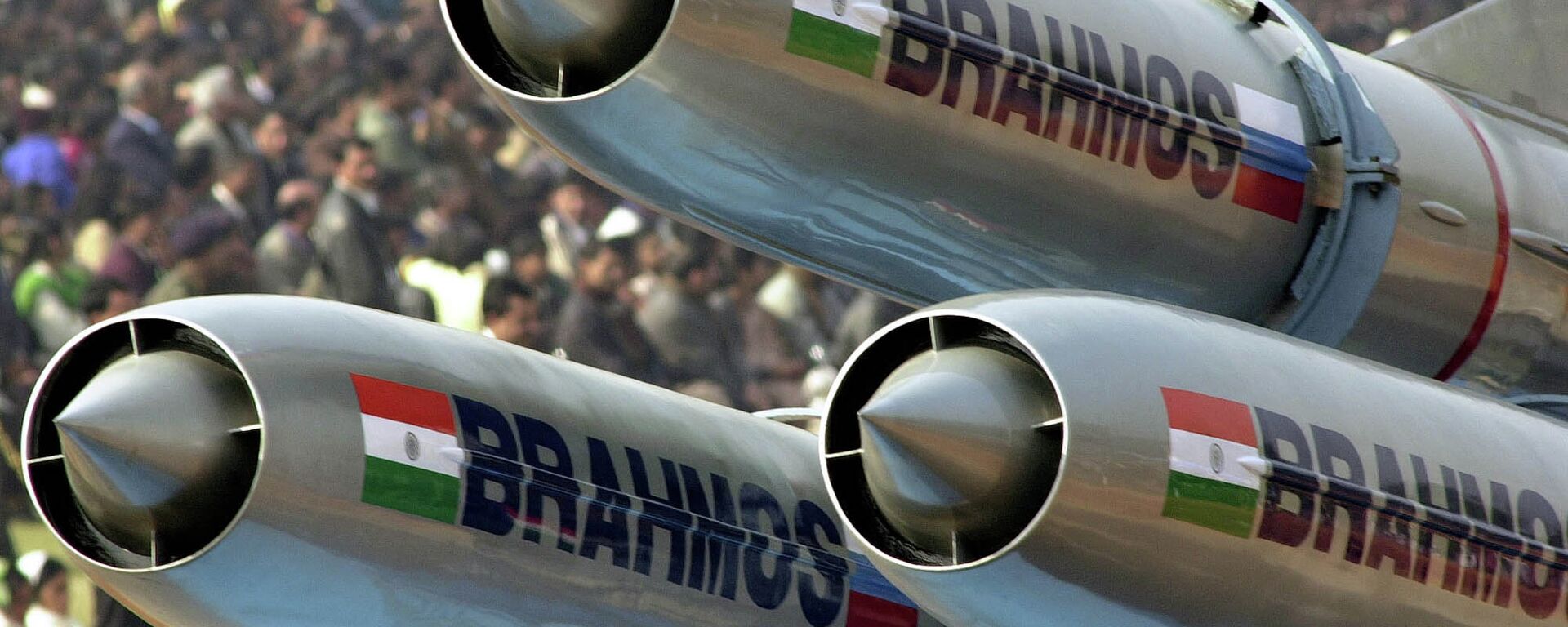Hypersonic Variant of BrahMos in the Pipeline: CEO
08:00 12.06.2024 (Updated: 10:46 12.06.2024)

© AP Photo / AJIT KUMAR
Subscribe
Exclusive
On the 26th anniversary of the BrahMos missile, the company's chief and deputy chief reveal plans for the projectile's future, including maximising its export potential and revolutionising India's combat prowess through the BrahMos-NG amongst others.
After the stupendous success of the BrahMos supersonic cruise missile which sends shivers down the spines of India's adversaries, a hypersonic variant of the rocket was in the pipeline, the CEO of its manufacturer, BrahMos Aerospace has said.
For the unversed, BrahMos is widely regarded as the fastest cruise missile in the world and has often earned widespread appreciation from military pundits for its untraceability.
In a wide-ranging exclusive interview with Sputnik India on Wednesday, BrahMos Aerospace's CEO Atul Dinkar Rane & Deputy CEO Dr. Sanjeev Kumar Joshi discuss about the growing importance of the BrahMos in the world, its advancements in the future, the Indo-Russian joint venture's (JV) market expansion and consolidation plans across the globe.
Sputnik: This 26th anniversary of BrahMos coincides with Russia's National Day. How significant is this milestone in highlighting the successful Indo-Russian collaboration, and what message does it send about the strength of our bilateral defense ties?
Atul Rane & Dr. Sanjeev Joshi: As "special" and "privileged" strategic partners, India and Russia have shared strong bilateral bond for over seven decades. BrahMos remains an outstanding product born out of excellent Military-Technical Collaboration between the two partner nations. The historic maiden launch of supersonic BrahMos undertaken 23 years ago on June 12, 2001 coincided with the Russian National Day.
For the unversed, BrahMos is widely regarded as the fastest cruise missile in the world and has often earned widespread appreciation from military pundits for its untraceability.
In a wide-ranging exclusive interview with Sputnik India on Wednesday, BrahMos Aerospace's CEO Atul Dinkar Rane & Deputy CEO Dr. Sanjeev Kumar Joshi discuss about the growing importance of the BrahMos in the world, its advancements in the future, the Indo-Russian joint venture's (JV) market expansion and consolidation plans across the globe.
Sputnik: This 26th anniversary of BrahMos coincides with Russia's National Day. How significant is this milestone in highlighting the successful Indo-Russian collaboration, and what message does it send about the strength of our bilateral defense ties?
Atul Rane & Dr. Sanjeev Joshi: As "special" and "privileged" strategic partners, India and Russia have shared strong bilateral bond for over seven decades. BrahMos remains an outstanding product born out of excellent Military-Technical Collaboration between the two partner nations. The historic maiden launch of supersonic BrahMos undertaken 23 years ago on June 12, 2001 coincided with the Russian National Day.
Since then, BrahMos has firmed up its position as world's fastest and deadliest precision strike weapon infused with cutting-edge technologies and impeccable capabilities. India and Russia have always worked "hand-in-hand" in making BrahMos what it is today.
From designing and delivering the 'universal' missile to the Indian Armed Forces to getting the historic export order from the Republic of Philippines, Russia has always provided its unequivocal support to the weapon programme. Today, BrahMos stands out as the most shining emblem of bilateral defence cooperation between India and Russia.

Atul Rane & Dr. Sanjeev Joshi, BrahMos
© Photo
Sputnik India: You both assumed your roles at BrahMos in December 2021, as nominated by DRDO. Could you discuss the key changes you have implemented over the past 2.5 years and highlight some of the notable achievements during your tenure?
Atul Rane & Dr. Sanjeev Joshi: Our focus and priority areas in these two and half years have been on:
1) Understanding and fulfilling the requirements of our Armed Forces
2) Harnessing the export potential of BrahMos
3) Major push towards indigenisation leading to production
We have realised many successes with this approach which include major contracts received by BrahMos Aerospace during this very short timeline. We have signed landmark contracts, including "India's biggest export deal" with the Republic of the Philippines (worth around US$375 million).
Atul Rane & Dr. Sanjeev Joshi: Our focus and priority areas in these two and half years have been on:
1) Understanding and fulfilling the requirements of our Armed Forces
2) Harnessing the export potential of BrahMos
3) Major push towards indigenisation leading to production
We have realised many successes with this approach which include major contracts received by BrahMos Aerospace during this very short timeline. We have signed landmark contracts, including "India's biggest export deal" with the Republic of the Philippines (worth around US$375 million).
We have also received an order for Mobile Coastal Batteries for the Indian Navy. And most recently, we have won our largest-ever order worth around INR 20,000 Crore ($2.39 billion) from Indian Navy for advanced BrahMos systems. So, the total orders in these 2.5 years of our small stint is worth around INR 34,000 Crore ($4.06 billion).
Apart from these successes in the business front, we have also achieved significant milestones in our indigenisation efforts to the tune of 83% after successful flight trials of our own indigenous seeker, booster, some more materials and components. We have also pushed for indigenisation towards production of these major sub-systems within this time period.
For instance, our industry partners are now producing the booster since last one year. After successful seeker trials, we have also placed the seeker production order with our industry partner. There are many other examples too at smaller components and sub-systems levels where we have matched our development rates with production orders to boost the Indian industries, including MSMEs. BrahMos is going to reap its benefits in near future.
At organizational level also, we have implemented many new policies which are pushing the company to achieve its mission goals faster, converging towards its vision.
Apart from these successes in the business front, we have also achieved significant milestones in our indigenisation efforts to the tune of 83% after successful flight trials of our own indigenous seeker, booster, some more materials and components. We have also pushed for indigenisation towards production of these major sub-systems within this time period.
For instance, our industry partners are now producing the booster since last one year. After successful seeker trials, we have also placed the seeker production order with our industry partner. There are many other examples too at smaller components and sub-systems levels where we have matched our development rates with production orders to boost the Indian industries, including MSMEs. BrahMos is going to reap its benefits in near future.
At organizational level also, we have implemented many new policies which are pushing the company to achieve its mission goals faster, converging towards its vision.

BrahMos missile
© Photo
Sputnik India: As the third CEO & MD of BrahMos, following the impactful 26 supersonic years of excellence of BrahMos Aerospace, how do you perceive the evolution and growth of BrahMos under your leadership since 2021, especially in the context of Indo-Russian partnership?
Atul Rane: It has been an incredible and unstoppable journey of evolution and growth. Russia has always been a pillar of strength for us in this JV programme and we have received unflinching support from our partner in every aspect – be it development of the weapon or its indigenisation or exports to third party foreign customer nations.
Atul Rane: It has been an incredible and unstoppable journey of evolution and growth. Russia has always been a pillar of strength for us in this JV programme and we have received unflinching support from our partner in every aspect – be it development of the weapon or its indigenisation or exports to third party foreign customer nations.
As I mentioned earlier, we received our historic export order from the Republic of Philippines in January 2022 and recently we have initiated the deliveries of the missile batteries to the Armed Forces of Philippines.
In this landmark journey, we have received our JV partner's support through and through because of which we have been able to achieve this historic milestone. Likewise, in our 'Make-in-India' endeavors towards missile indigenisation, scientists from our JV partner’s side have always been forthcoming in this regard.
The indigenisation level today has reached over 80% which is a remarkable achievement for us. So, in these two and half years, the BrahMos JV has further strengthened its imprints, not only domestically but also internationally.
Sputnik India: How would you describe the level of confidence and trust that the Indian Armed Forces and the missile's first export customer, the Philippines, place in the BrahMos missile system? How does this trust influence your strategy for future exports?
Atul Rane: For Indian Armed Forces, BrahMos remains their foremost weapon of choice. The continuous order flows from the Tri-Services for the tactical missile is testimony to this fact. Our Army has raised several BrahMos LACM regiments since its first induction in 2007.
In this landmark journey, we have received our JV partner's support through and through because of which we have been able to achieve this historic milestone. Likewise, in our 'Make-in-India' endeavors towards missile indigenisation, scientists from our JV partner’s side have always been forthcoming in this regard.
The indigenisation level today has reached over 80% which is a remarkable achievement for us. So, in these two and half years, the BrahMos JV has further strengthened its imprints, not only domestically but also internationally.
Sputnik India: How would you describe the level of confidence and trust that the Indian Armed Forces and the missile's first export customer, the Philippines, place in the BrahMos missile system? How does this trust influence your strategy for future exports?
Atul Rane: For Indian Armed Forces, BrahMos remains their foremost weapon of choice. The continuous order flows from the Tri-Services for the tactical missile is testimony to this fact. Our Army has raised several BrahMos LACM regiments since its first induction in 2007.
For our Navy, BrahMos remains the "prime strike weapon" having been installed on almost all frontline warships since 2005. For the Indian Air Force, it is the most powerful airborne stand-off weapon with precision firepower to neutralise both ground and sea-based targets from far-off ranges. So, versatile BrahMos has provided modern network-centric capabilities to India’s Armed Forces.
We have recently initiated the delivery of BrahMos shore-based anti-ship missile batteries to our first foreign customer country – the Philippines. The Philippine Marine Corps are highly impressed with the weapon's cutting-edge technologies and impeccable capabilities. They have expressed their happiness and satisfaction for the weapon system and also with our training programmes and the world-class (missile) storage facilities being built there.
Sputnik India: How confident are you about securing a second order from the Philippines since Manila is looking to acquire the BrahMos for its Army after the Marines?
Atul Rane: We are quite confident about this. Once we successfully execute our first order, we would be in a much stronger position to get this fresh order from the Philippine Army. As we stick to the delivery timelines along with a strong commitment to maintain highest standards in the quality of deliverables, robust after-sales service & support in addition to capacity building and capacity enhancement efforts, we would definitely be well-positioned to receive more orders in near future.
Sputnik India: Has there been a jump in interest shown by foreign nations in the BrahMos after the missile's delivery to the Philippines? Could you please share the names of countries that have approached BrahMos Aerospace for a demonstration of the missile?
Atul Rane: The interest shown in BrahMos is quite evident and we have witnessed it during major national and international defence expositions we have attended in past few months. We have received several inquires from many potential customer nations, especially after our first export breakthrough with the Philippines which we realised in January 2022. There are over a dozen countries which have evinced keen interest in the versatile weapon system and they are from across continents including from Southeast Asia, North Africa, Middle East and Latin America.
Sputnik India: Reducing the import content in BrahMos is important for making it affordable for foreign nations. Have you set a timeline to achieve complete indigenization of BrahMos?
Atul Rane: We must have to understand that BrahMos is a JV company which needs to take care the interests of the Company, the stakeholders and the JV partners, while aligning with Government’s guidelines and policies. Towards self-reliance in defence, BrahMos is moving fast forward towards indigenisation goals. And today, we can say that the level of indigenisation in BrahMos has reached up to 83%, to be precise. This has significantly reduced the overall production, operation and maintenance costs of the missile system.
However, achieving 100% indigenisation is neither feasible nor desirable as BrahMos is a Joint Venture defence programme.
As regards to affordability to foreign customer nations, then we are offering them a very cost-effective and yet the most powerful precision strike system which is unparalleled in the world in terms of its technologies and capabilities.
We have recently initiated the delivery of BrahMos shore-based anti-ship missile batteries to our first foreign customer country – the Philippines. The Philippine Marine Corps are highly impressed with the weapon's cutting-edge technologies and impeccable capabilities. They have expressed their happiness and satisfaction for the weapon system and also with our training programmes and the world-class (missile) storage facilities being built there.
Sputnik India: How confident are you about securing a second order from the Philippines since Manila is looking to acquire the BrahMos for its Army after the Marines?
Atul Rane: We are quite confident about this. Once we successfully execute our first order, we would be in a much stronger position to get this fresh order from the Philippine Army. As we stick to the delivery timelines along with a strong commitment to maintain highest standards in the quality of deliverables, robust after-sales service & support in addition to capacity building and capacity enhancement efforts, we would definitely be well-positioned to receive more orders in near future.
Sputnik India: Has there been a jump in interest shown by foreign nations in the BrahMos after the missile's delivery to the Philippines? Could you please share the names of countries that have approached BrahMos Aerospace for a demonstration of the missile?
Atul Rane: The interest shown in BrahMos is quite evident and we have witnessed it during major national and international defence expositions we have attended in past few months. We have received several inquires from many potential customer nations, especially after our first export breakthrough with the Philippines which we realised in January 2022. There are over a dozen countries which have evinced keen interest in the versatile weapon system and they are from across continents including from Southeast Asia, North Africa, Middle East and Latin America.
Sputnik India: Reducing the import content in BrahMos is important for making it affordable for foreign nations. Have you set a timeline to achieve complete indigenization of BrahMos?
Atul Rane: We must have to understand that BrahMos is a JV company which needs to take care the interests of the Company, the stakeholders and the JV partners, while aligning with Government’s guidelines and policies. Towards self-reliance in defence, BrahMos is moving fast forward towards indigenisation goals. And today, we can say that the level of indigenisation in BrahMos has reached up to 83%, to be precise. This has significantly reduced the overall production, operation and maintenance costs of the missile system.
However, achieving 100% indigenisation is neither feasible nor desirable as BrahMos is a Joint Venture defence programme.
As regards to affordability to foreign customer nations, then we are offering them a very cost-effective and yet the most powerful precision strike system which is unparalleled in the world in terms of its technologies and capabilities.

Dr. Sanjeev Joshi at BrahMos HQ
© Photo
Sputnik India: The high cost of BrahMos has been a concern for both customer countries and the armed forces. What strategies are being implemented to make the missile system more cost-effective while maintaining its superior quality?
Atul Rane: There has never been such an issue like high costs. On the contrary, we offer the most cost-effective missile system as compared to any other cruise missile in the world. Here, several factors comes into play such as quality, reliability, precision, high-end technology, versatility, supersonic speed all through-out flight, enhanced shelf-life, world-class storage, maintenance & check-out facilities, logistical & operational training along with comprehensive post-sales services & support. So when all these parameters are put together, then the cost of ownership definitely goes down. Hence, any customer who decides to acquire BrahMos needs to understand all these aspects.
In addition, the "strike time" of BrahMos remains incomparable. At speed of 2.8 Mach, BrahMos takes appx. 5 minutes to reach its target at 290-km, while others take somewhere around 15-20 minutes, making them vulnerable to be intercepted. During war time, swift response is the key and as a powerful deterrent system, BrahMos remains un-interceptable. So, we are convincing all our potential foreign customer nations with all these above facts about BrahMos.
Sputnik India: The development of an Indigenous ramjet engine for BRAHMOS has been a key thrust area for DRDO. How much cost reduction in a single unit of BrahMos could be achieved through this endeavor?
Atul Rane: Yes, the development of ramjet engine remains the foremost priority interest area for DRDO. It is a very critical and complex technology. If and when we achieve it successfully, we expect to be able to reduce per unit BrahMos production cost.
Sputnik India: Considering the complexities of the defense ecosystem and its supply chain, what are your expectations from the industry partners you collaborate with to ensure smooth operations and innovations?
Atul Rane: Supply chain in Defence eco-system is a very important factor. Having the right balance is essential as far as the number of industry partners is concerned to design and develop any components or subsystems for the weapon. Our expectations from the industry partners associated with us is to increase their overall capacity to produce more and more number of components and sub-systems for BrahMos by investing more.
Atul Rane: There has never been such an issue like high costs. On the contrary, we offer the most cost-effective missile system as compared to any other cruise missile in the world. Here, several factors comes into play such as quality, reliability, precision, high-end technology, versatility, supersonic speed all through-out flight, enhanced shelf-life, world-class storage, maintenance & check-out facilities, logistical & operational training along with comprehensive post-sales services & support. So when all these parameters are put together, then the cost of ownership definitely goes down. Hence, any customer who decides to acquire BrahMos needs to understand all these aspects.
In addition, the "strike time" of BrahMos remains incomparable. At speed of 2.8 Mach, BrahMos takes appx. 5 minutes to reach its target at 290-km, while others take somewhere around 15-20 minutes, making them vulnerable to be intercepted. During war time, swift response is the key and as a powerful deterrent system, BrahMos remains un-interceptable. So, we are convincing all our potential foreign customer nations with all these above facts about BrahMos.
Sputnik India: The development of an Indigenous ramjet engine for BRAHMOS has been a key thrust area for DRDO. How much cost reduction in a single unit of BrahMos could be achieved through this endeavor?
Atul Rane: Yes, the development of ramjet engine remains the foremost priority interest area for DRDO. It is a very critical and complex technology. If and when we achieve it successfully, we expect to be able to reduce per unit BrahMos production cost.
Sputnik India: Considering the complexities of the defense ecosystem and its supply chain, what are your expectations from the industry partners you collaborate with to ensure smooth operations and innovations?
Atul Rane: Supply chain in Defence eco-system is a very important factor. Having the right balance is essential as far as the number of industry partners is concerned to design and develop any components or subsystems for the weapon. Our expectations from the industry partners associated with us is to increase their overall capacity to produce more and more number of components and sub-systems for BrahMos by investing more.
As both domestic as well global demand for BrahMos grows, it is high time for our industry partners to scale-up their production capabilities to meet such huge demands in future which would not only bring uninterrupted work flow, but also reduce the overall production cost due to economies of scale.
Sputnik India: What is the level of private sector partnership in the manufacturing of BrahMos missiles? Are MSMEs involved in your chain of production?
Atul Rane: The level of private sector partnership is quite significant as many large, medium & small private sector players are associated with us. Yes, MSMEs too are involved in our chain of production.
Sputnik India: If you had the opportunity to make specific requests to the Indian government to support BrahMos Aerospace, what would be at the top of your wishlist?
Atul Rane: BrahMos is a JV with 50.5% shareholding of GOI and rest is with Russia. The very formation of this company had a core understanding to give it autonomy and freedom to create ripples in the world by producing a world-class missile. BrahMos was able to develop this product successfully.
Sputnik India: What is the level of private sector partnership in the manufacturing of BrahMos missiles? Are MSMEs involved in your chain of production?
Atul Rane: The level of private sector partnership is quite significant as many large, medium & small private sector players are associated with us. Yes, MSMEs too are involved in our chain of production.
Sputnik India: If you had the opportunity to make specific requests to the Indian government to support BrahMos Aerospace, what would be at the top of your wishlist?
Atul Rane: BrahMos is a JV with 50.5% shareholding of GOI and rest is with Russia. The very formation of this company had a core understanding to give it autonomy and freedom to create ripples in the world by producing a world-class missile. BrahMos was able to develop this product successfully.
Government of India has already formulated many positive policies like the Defence Acquisition Procedure (DAP) 2020 and Defence Production & Export Promotion Policy (DPEPP) for acquisition and export of Indian Weapon systems. The Indian MoD has always been supportive to this cause. DRDO is immensely helping in indegenisation of the weapon system. So, everything is being taken care of and there are no wishlists from our side.
Sputnik India: The Indian Navy recently placed the largest-ever purchase order for BrahMos missiles. Can you elaborate on the significance of this order and its impact on the Indo-Russian joint venture?
Atul Rane: Yes, this huge order was placed in March 2024 worth around INR 20,000 crore ($2.39 billion) to deliver enhanced BrahMos systems to Indian Navy. It has become the largest-ever order for the JV to produce and supply the missiles to our Navy. This order has further bolstered our orderbook and ensured uninterrupted work-flow for the JV.
Sputnik India: What financial strategies has BrahMos Aerospace employed to manage costs while ensuring the highest quality and reliability of its missile systems?
Atul Rane & Dr. Sanjeev Joshi: Indigenisation has always been a priority area. We have achieved significant levels of indigenisation in BrahMos programme. The MIC (missile-industrial consortium ) framework has worked well to consolidate our supply chains while expanding the defence eco-system within the country.
Sputnik India: The Indian Navy recently placed the largest-ever purchase order for BrahMos missiles. Can you elaborate on the significance of this order and its impact on the Indo-Russian joint venture?
Atul Rane: Yes, this huge order was placed in March 2024 worth around INR 20,000 crore ($2.39 billion) to deliver enhanced BrahMos systems to Indian Navy. It has become the largest-ever order for the JV to produce and supply the missiles to our Navy. This order has further bolstered our orderbook and ensured uninterrupted work-flow for the JV.
Sputnik India: What financial strategies has BrahMos Aerospace employed to manage costs while ensuring the highest quality and reliability of its missile systems?
Atul Rane & Dr. Sanjeev Joshi: Indigenisation has always been a priority area. We have achieved significant levels of indigenisation in BrahMos programme. The MIC (missile-industrial consortium ) framework has worked well to consolidate our supply chains while expanding the defence eco-system within the country.
By collaborating with the industry partners, laboratories, academic institutions etc., we have achieved remarkable progress. Indigenisation leading to production and production leading to desired production rate by our industry partners will further help in reduction of cost. Continuous order flow from the Indian Armed Forces is also helping us. All these factors will enable us to reduce the cost while maintaining highest quality and reliability of the weapon.

Atul Rane at BrahMos HQ
© Photo
Sputnik India: How does BrahMos Aerospace plan to expand its market presence globally, and what financial investments are being made to support this growth strategy? What role does the Indo-Russian collaboration play in these expansion plans?
Atul Rane & Dr. Sanjeev Joshi: We have been taking part in international defence exhibitions to promote our product to potential customer nations as part of our "Mind-to-Market" strategy. There is a dedicated team of Market Promotions & Export which looks for potential leads. We have been receiving full support and cooperation from both the partner nations’ governments to consolidate our market presence internationally.
Atul Rane & Dr. Sanjeev Joshi: We have been taking part in international defence exhibitions to promote our product to potential customer nations as part of our "Mind-to-Market" strategy. There is a dedicated team of Market Promotions & Export which looks for potential leads. We have been receiving full support and cooperation from both the partner nations’ governments to consolidate our market presence internationally.
Sputnik India: Are there plans to sell the BrahMos missile to Russia? Has Russia approached you on this matter?
Atul Rane & Dr. Sanjeev Joshi: There are no such plans as of now.
Sputnik India: With India's neighbors inducting hypersonic missiles in their arsenal, are you planning to expedite the development of a hypersonic BrahMos missile? If yes, when can we expect the missile to be rolled out?
Atul Rane & Dr. Sanjeev Joshi: Hypersonic BrahMos is in our pipeline. However, a definite timeline for its development can not be provided at this stage. Presently, we are working on the BrahMos-NG programme. Once we realise it successfully, we would consider working on the more advanced hypersonic BrahMos variant.
Sputnik India: Development trials of BrahMos-NG are set to begin next year. Could you please explain how it would be different from the original BrahMos?
Atul Rane & Dr. Sanjeev Joshi: BrahMos-NG would be a smaller, lighter and smarter derivative of existing BrahMos. It would feature smart guidance, avionics, next-gen stealth among other advancements. Owing to its reduced size and weight, it would be deployed on many modern military platforms (ground, ship, air) in more numbers. This new smart & compact missile promises to be a revolutionary inclusion in the battlefields of tomorrow.
Atul Rane & Dr. Sanjeev Joshi: Hypersonic BrahMos is in our pipeline. However, a definite timeline for its development can not be provided at this stage. Presently, we are working on the BrahMos-NG programme. Once we realise it successfully, we would consider working on the more advanced hypersonic BrahMos variant.
Sputnik India: Development trials of BrahMos-NG are set to begin next year. Could you please explain how it would be different from the original BrahMos?
Atul Rane & Dr. Sanjeev Joshi: BrahMos-NG would be a smaller, lighter and smarter derivative of existing BrahMos. It would feature smart guidance, avionics, next-gen stealth among other advancements. Owing to its reduced size and weight, it would be deployed on many modern military platforms (ground, ship, air) in more numbers. This new smart & compact missile promises to be a revolutionary inclusion in the battlefields of tomorrow.


